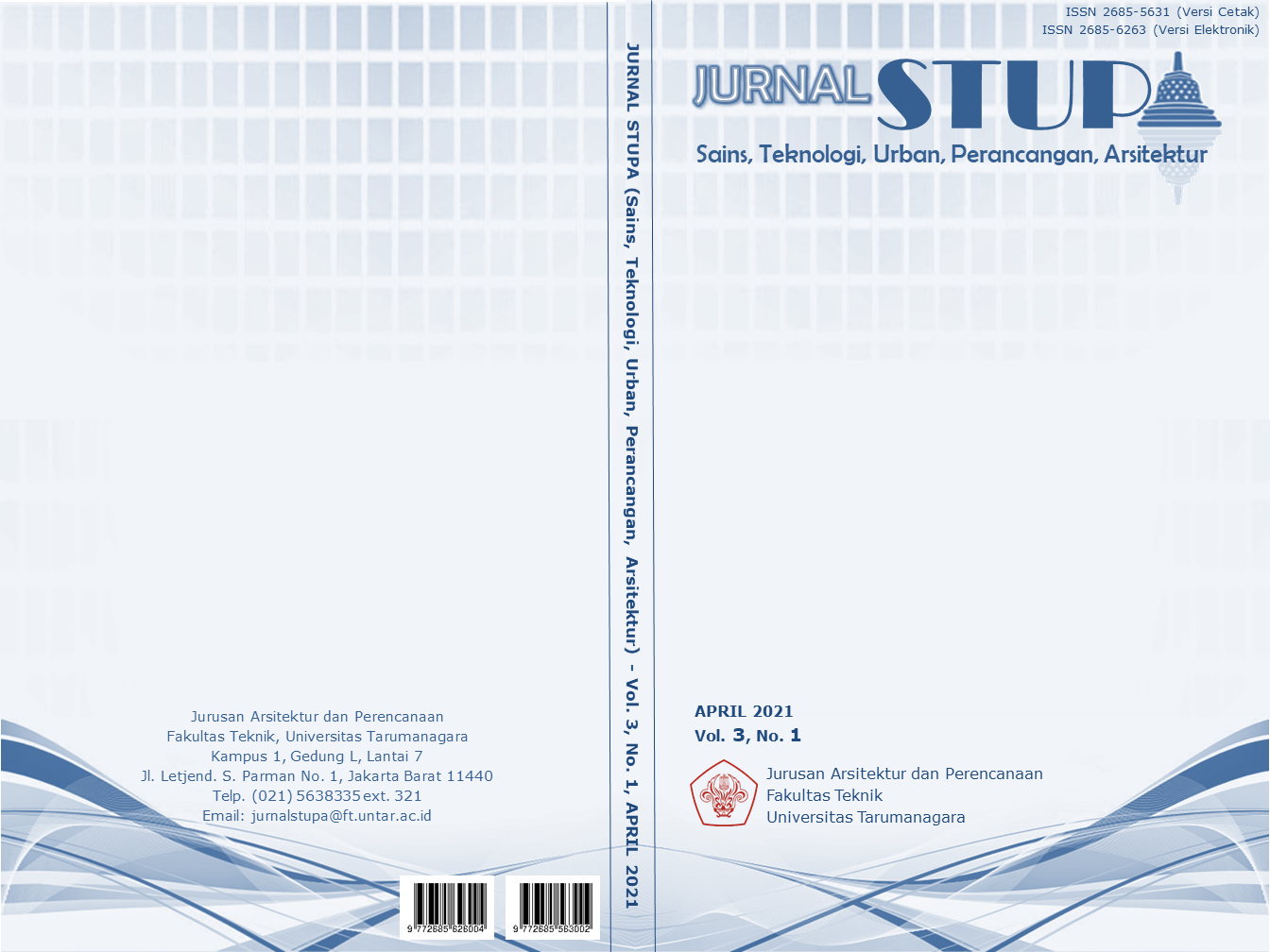RUMAH SINGGAH KANKER ANAK DENGAN TERAPI PALIATIF
Main Article Content
Abstract
Hospitals that can treat pediatric cancer are usually located in big cities, for example Jakarta. For children with cancer who come from outside the region and their families are unable to pay for hospitalization, they are forced to travel back and forth which takes a lot of time and transportation fees. Apart from medical care, the children with cancer also need palliative care, which is an integrated care system approach to improve the quality of life for patients and their families when facing life-threatening terminal illnesses by providing spiritual and psychosocial support from the time the diagnosis is made to the end of life for cancer patients. The solution is to design a childhood cancer lodging that has palliative therapy facilities with child-friendly and appropriate design references, and is located close to a referral hospital for pediatric cancer. The design of the lodging aims to make a shelter that is not only served as “the second home” for children with cancer, but also as a place for recreation, relaxation, and education. The formation and arrangement of architectural spaces of the lodging refers to the connection between human activities and their environment. The design concept of the site is Urban Oasis. The building seems to be in the middle of a forest with a small river that surrounds it. Here, apart from getting spiritual and psychosocial support, children can also take up their hobbies in the arts and music, relieve stress after undergoing medical treatment through interactions with animals and nature, as well as play and learn together.
Keywords: childhood cancer lodging; everydayness architecture; future dwelling; healing environment; palliative care
Abstrak
Rumah sakit yang dapat menangani anak penderita kanker umumnya berada di kota besar, contohnya Jakarta. Bagi anak-anak penderita kanker yang berasal dari luar daerah dan keluarganya tidak mampu membiayai rawat inap di rumah sakit, mereka terpaksa melakukan perjalanan pulang pergi yang memakan banyak waktu dan biaya transportasi. Selain perawatan medis, para penderita kanker juga membutuhkan perawatan paliatif; yang merupakan pendekatan sistem perawatan terpadu untuk meningkatkan kualitas hidup pasien dan keluarga mereka ketika menghadapi penyakit terminal yang membahayakan jiwa, dengan memberikan dukungan spiritual dan psikososial; mulai saat diagnosis ditegakkan sampai pada akhir hidup pasien kanker. Solusi dari isu tersebut adalah merancang rumah singgah kanker anak yang memiliki fasilitas terapi paliatif dengan acuan desain yang ramah anak dan sesuai dengan kebutuhan anak-anak penderita kanker, serta letaknya dekat dengan rumah sakit rujukan untuk kanker anak. Perancangan rumah singgah kanker anak dengan terapi paliatif ini bertujuan untuk merancang rumah singgah yang tidak hanya sebagai tempat tinggal alternatif bagi anak-anak penderita kanker, namun juga sebagai tempat rekreasi, relaksasi, dan edukasi. Pembentukan dan pengaturan ruang arsitektural dari rumah singgah mengacu pada keterkaitan antara aktivitas manusia dan lingkungannya. Konsep desain dari perancangan tapak yaitu Urban Oasis. Bangunan seakan-akan berada di tengah-tengah hutan yang rindang dengan sungai kecil yang mengelilinginya. Di sini, selain mendapatkan dukungan spiritual dan psikososial, anak-anak juga dapat menyalurkan hobi mereka dalam bidang seni dan musik, melepas stress setelah menjalani perawatan medis melalui interaksi dengan hewan dan alam, juga bermain dan belajar bersama.
Article Details
References
Antoniades, C. A. (1990). Poetics Of Architecture. New York: Van Nostrand Reinhold Co.
Fricke O.P.; Halswick D.; Langler A.; Martin D.D. (2020). Healing architecture for sick kids: Concepts of environmental and architectural factors in child and adolescent psychiatry. Zeitschrift fur Kinder- und Jugendpsychiatrie und Psychotherapie, 47(1). 27-33
Gola, Marco, Paolo Carlo Francalanza, Giulio Galloni, Bianca Pagella, & Stefano Capolongo. (2016). Architectures for paediatric palliative care: how to improve quality of life and environmental well-being. Ann Ist Super Sanità, 52(1), 48-55.
Heidegger, M. (1971). Building, Dwelling, Thinking. New York: Harper Colophon Books.
Jencks, C. (2015). The Architecture of Hope: Maggie's Cancer Caring Centres. London: Frances Lincoln.
Norberg-Schulz, C. (1985). The Concept of Dwelling: On the Way to Figurative Architecture. New York: Rizzoli.
Plowright, P. D. (2014). Revealing Architecture: Methods, Frameworks and Tools. New York: Routledge.
Sharr, A. (2007). Heidegger for Architects. New York: Routledge.
Simonds, J. (1961). Landscape Architecture. New York: McGraw Hill Co.
Sutanto, A. (2020). Peta Metode Desain. [Electronic version]. Jakarta: Universitas Tarumanagara
Sutanto, A, dan Andani, A.. (2020). Strategi Komposisi Massa. [Electronic version]. Jakarta: Universitas Tarumanagara
Verderber, S., dan Ben J. R. (2006). Innovations in Hospice Architecture. [Electronic version]. New York: Taylor & Francis.
Verderber, S. (2014). Residential Hospice Environments: Evidence-based architectural and landscape design considerations. Journal of Palliative Care, 30(2), 69–82.
Detik Health. (2012). Rumah Singgah Kanker, Rumah Kedua Bagi Pasien Kanker Tak Mampu. Diakses 6 Agustus 2020, dari https://health.detik.com/ulasan-khas/d-1952387/rumah-singgah-kanker-rumah-kedua-bagi-pasien-kanker-tak-mampu
Gould, Rachel. (2017). How Architecture Plays a Role in Bringing Hope to Cancer Patients. Diakses 24 Agustus 2020, dari https://medium.com/the-omnivore/how-architecture-plays-a-role-in-bringing-hope-to-cancer-patients-a33aa223015
Kementrian Kesehatan Republik Indonesia. (2019). Hari Kanker Sedunia 2019. Diunduh 10 Agustus 2020, dari https://www.kemkes.go.id/article/view/19020100003/hari-kanker-sedunia2019.html
Knecht, Michael L. (2010). Optimal Healing Environments. Healthy Communities by Design : Redlands and Loma Linda, CA. Diunduh 2 Agustus 2020, dari https://proceedings.esri.com/library/userc%20onf/healthy%20communities10/pdfs/optimalhealingenvironments.pdf.
Manafe, Dina. (2019). Prevalensi Kanker di Indonesia Meningkat. Diunduh 2 Agustus 2020, dari https://www.beritasatu.com/kesehatan/535688-prevalensi-kanker-di-indonesiameningkat
Medina, Samuel. (2014). Architecture Gives Cancer Patients Care Courage. Diakses 24 Agustus 2020, dari https://www.metropolismag.com/architecture/healthcarearchitecture/architecture-gives-cancer-patients-care-courage/
Organisasi Lawan Kanker. (2016). Daftar Rumah Singgah Kanker di Indonesia. Diakses 13 Agustus 2020, dari https://lawankanker.org/daftar-rumah-singgah-kanker-di-indonesia/
Puji, Aprinda. (2020). Kanker. Diakses 9 Agustus 2020, dari https://hellosehat.com/kanker/pengertian-kanker/
Sihombing, Rosmery. (2019). Semangat Sembuh dari Rumah Singgah. Diakses 23 Agustus 2020, dari https://mediaindonesia.com/read/detail/230159-semangat-sembuh-dari-rumahsinggah
Tomboc, Kai. (2019). Cancer in Children Facts and Statistics: A Visual Case Study. Diunduh 2 Agustus 2020, dari https://www.easel.ly/blog/cancer-in-children-infographics/
World Health Organization. (2018). Cancer in Children. Diunduh 2 Agustus 2020, dari https://www.who.int/news-room/fact-sheets/detail/cancer-in-children



